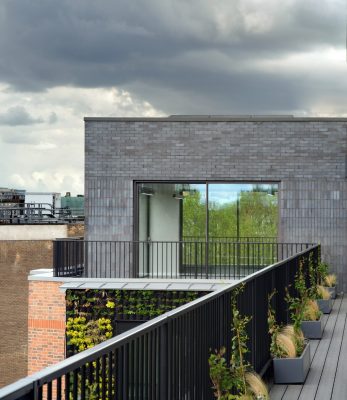Holbein Gardens, Southwest London Office Building Redevelopment, Architecture Photos
Holbein Gardens Office Building in Chelsea
14 Aug 2023
Design: Architect Barr Gazetas
Location: Chelsea, south west London, England, UK
Holbein Gardens, London
Architect Barr Gazetas has completed the transformation of Holbein Gardens, a 1980s office building in Chelsea, for client Grosvenor.
Constructed within the UKGBC’s Net Zero Carbon Buildings Framework, the building is Grosvenor’s flagship Net Zero development, and offers 26,500 sq. ft of high quality, flexible and sustainable workspace. Now one of the UK’s most sustainable office buildings, Barr Gazetas’s transformation exceeds LETI Pioneer Project targets, achieving 300 kg CO2/m2 of embodied carbon.
Untouched since its original completion in the 1980s, the previously tired building near Sloane Square has been reimagined to create a light-filled sustainable workspace in place of the previously dated and uninspiring office building. The existing five-storey structure has been retained, whilst the mansard roof has been removed to enable the addition of a sixth floor, with floor to ceiling windows and a landscaped roof terrace with panoramic views across London.
Developed using Circular Economy principles, Barr Gazetas’s design maximises the reuse of building elements wherever possible. This philosophy extends to the structural frame of the building, which makes use of nine tonnes of steel sourced from a nearby demolition site within the Grosvenor portfolio. This has been combined with an additional 15 tonnes of reused steelwork from Cleveland Steel and refabricated to form the building’s rooftop extension, where it is used in conjunction with CLT slabs. Overall, the use of reused steel reduced upfront embodied carbon on the project by approximately 60TCO2e.
Set back from the building perimeter, a sixth floor was added to create the outside terrace, increasing the gross internal floor area from 32,400 sq ft to 38,000 sq ft. The external landscaping has been transformed and a green wall was added to a side elevation, with window boxes and planting around the rooftop extension to increase biodiversity.
Barr Gazetas introduced innovative and sustainable solutions throughout the project including lime mortar for the bricks, Adaptavate breathable lime plaster, anti-pollutant tiles and Graphenstone sustainable paints. Reclaimed Staffordshire bricks and York stones were used for the ground floor landscaping, with planters made of CEMFREE concrete.
To reduce operational carbon emissions, key upgrades have been made to the building and its fabric. Contributing to heat retention and energy usage reduction, all existing windows were replaced with new high-performance versions and wall cavities filled. Implemented to improve climate resilience and wellbeing, the green wall helps cool the building, acting as a vertical bridge.
Contributing to Grosvenor’s goal for all managed buildings to be net zero operational carbon by 2030, the building is now all electric with heating and cooling supplied by air source heat pumps located in a small area on the roof with the rest of the plant in the basement.
Overall, 99.95% of strip-out waste has been diverted from landfill, surpassing best practices. An all-electric clean energy supply, material reuse and circular economy principles have enabled the scheme to be net zero carbon by 2030 and achieve a BREEAM Outstanding certification.
Pradumn Pamidighantam, Senior Architect at Barr Gazetas, said: “The achievements of this project are testament to the collaborative spirit with which the team approached the challenge, and to the open-mindedness and ambition of Grosvenor as client. Along with our partners, we pushed ourselves to interrogate every decision at each stage of delivery, and the result is a building that we are hugely proud of, and which genuinely pushes the envelope in terms of sustainability.
At a time when the industry is grappling with the threat of stranded assets as occupiers and investors demand ever greener offices, Holbein Gardens demonstrates the huge potential for transforming outdated building stock into exemplary low-carbon workspaces. By maximising retention, prioritising material reuse and introducing extensive greening, we have delivered a blueprint for building adaptation and retrofit in London and beyond.”
Tom White, Senior Project Manager at Grosvenor said: “”Transforming an outdated office building into one of London’s most sustainable office developments has been a hugely rewarding challenge. It’s fantastic to now be able to look to the next stage of its journey.
As one of the first developments to be delivered in line with Grosvenor’s Sustainable Development Brief, Holbein Gardens demanded ingenuity and enthusiasm from the whole project team. We’re incredibly proud of the end result and see it as an exemplar of how the use of reclaimed materials, low carbon technologies and good design can transform outdated buildings into modern net zero workspaces. ”
Robert Mills, Senior Associate at Heyne Tillett Steel, said: “Holbein Gardens reimagines an existing building to create a modern, sustainable workspace and has been brilliantly enabled through the vision of Barr Gazetas, to meet the aspirations of Grosvenor as the client. Working together as a team, we have been able to develop novel structural solutions that maximise the retention of the existing building fabric and use low carbon structural materials such as CLT, which all help to minimise the embodied carbon in the build. By pioneering the reuse of steel, the project demonstrates how reclaimed steel can be successfully incorporated into a commercial scheme and provides a fantastic example of circular economy principles in action.”
Holbein Gardens, Chelsea, London images / information received 140823
Location: Chelsea, south west London, England, UK
Architecture in London
London Architecture Links – chronological list
London Architecture Walking Tours by e-architect
St John’s Waterloo, 73 Waterloo Road, SE1
Design: Eric Parry Architects

photo : Dirk Lindner
St John’s Church Waterloo
Waterloo Station Masterplan News
Design: Grimshaw

image courtesy of architects practice
Waterloo Station Masterplan
School 360, Sugar House Lane, East London
Design: Penoyre & Prasad Architects

photo : Tim Crocker
School 360 Sugar House Island
Comments / photos for the Holbein Gardens, Chelsea Office Building building design by Architect Barr Gazetas page welcome


















